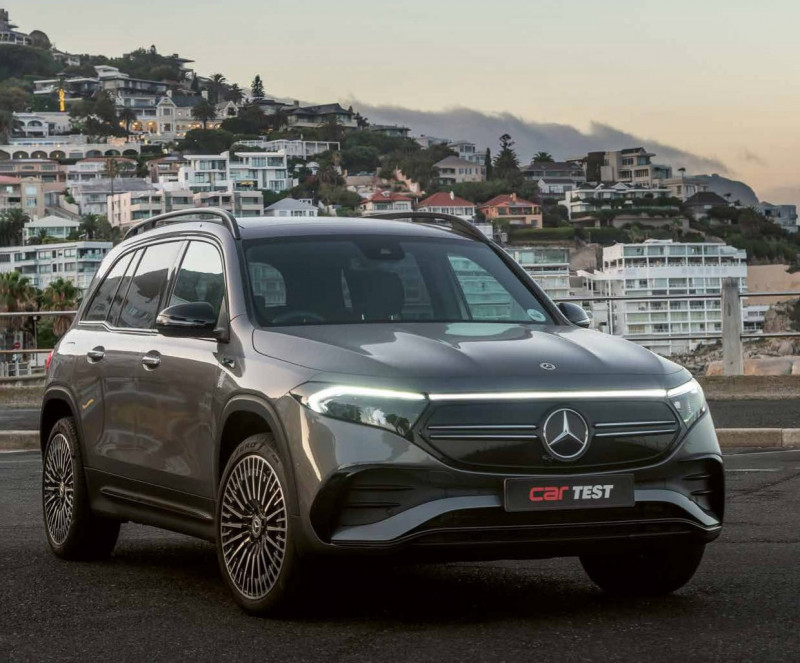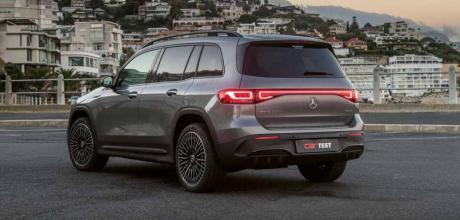2024 Mercedes-Benz EQB350 4Matic AMG Line X243
Nice but niche – 2024 Mercedes-Benz EQB 350 4Matic AMG Line.Of course, it’s not a real seven-seater, but that was never why you were considering it in the first place. So, where does it fit in?
Several years ago, while some commentators were quick to accuse fledgling Chinese auto manufacturers of shamelessly copying their trendsetting German counterparts – from luxo-hatches or land yachts built by BMW, Audi and Mercedes-Benz – what we’re seeing now, in truth, is no different.

Ownership of niches by a sole competitor is simply not allowed. The binary nature of segmentary leadership or imitatorship is a never-ending round of roulette exclusively determined by the swiftness and the madness of marketing executives.
Since launching in 2021 (locally in 2022), Mercedes has enjoyed a category-specific monopoly in its positioning of the EQB as an EV crossover with its optional seven seats. Based on the GLB SUV, the EQB’s transformation from diesel dinosaur to voltage vulture was a simple one, with mixed effect, it has to be said. It ditched the conventional powertrain in favour of an electric motor at each axle and it was fuelled by a rather small (and ahem, by extension, range-limiting) 66.5 kWh battery.
Curiously, MBSA opted to offer only one power specification in the EQB, which develops 215 kW and 520 N.m. This means, as with the more compact EQA entry EV, the three available derivatives are distinguished only by equipment grade. They ranging in price from R1 379 000 to R1 523 400.
Price-wise, our R1 432 000 AMG Line tester straddles the range and is most easily identified by its 20-inch spoke wheels (said to swallow nearly three per cent of the range when compared to the smaller variants) and inside, mixed leather seats as well as gofast blistered aluminium pedals.
All models come standard with self-dipping LED headlamps, keyless entry, navigation and parking assistance. Thereafter, buyers can brave the complicated Mercedes ladder of package-specific bundled enhancements comprising tech, safety, comfort and lighting features … more than 100 unique configurations. For both front- and secondrow occupants, courtesy of its SUV underpinnings, the EQB is bounteous in space and the views are panoramic.
Curiously, despite Mercedes’ unique selling proposition of the EQB as a seven-seater EV SUV, the test unit was not equipped as such. This is likely owing to the battery’s placement around the rear-axle area, which elevates the rearmost section of the cabin so only passengers shorter than 1,65 m can be accommodated. As a result, the claim of a game-changing seven-seater is open to interpretation.
The battery is another let-down. Apart from its limited storage capability (real-world demands such as highway speeds and extreme cabin climate control guzzle up to a third of capacity), when DC charging, it’s able to charge to a maximum speed of 100 kW only. Currently, its rivals are nearly doubling or tripling this rate.
The Volvo XC40 recharges at 150 kW and overseas, the Hyundai Ioniq charges at 350 kW. However, Mercedes-Benz claims getting from 10% to 80% should take about 32 minutes, which is acceptable.
A useful range-extending hack – for all EVs – is to precondition the cabin temperature to the preferred level while charging, not taxing the battery once on the move. After setting off in near silence and at slow speeds, the EQB will change direction surprisingly crisply, although the directness of its steering seems at odds with the height of the vehicle. There is the obligatory EV party trick – hot-hatch-humbling bursts of peak torque – before physics and battery preservation prematurely spoil the party.
Limited demand means the torque allocation is sent primarily to the rear axle before a playful right ankle awakens the front. While this does not stretch the G-force, the shuffle of front/rear torque (measured 100 times per second) makes for a pleasing, albeit neutral experience, which is dominated by the heavy tugging of magnetic motors.
As in Audi e-trons, the steering-wheel- mounted paddles manage the severity of the regenerative braking. There’s no way to disable it in the Mercedes. Even its default mode – there are three – is quite aggressive. In its most extreme mode, true one-pedal driving is possible, although dead stops demand finishing off with a brush of the brake pedal.
It is worth noting that the two-plus-tonne EQB was the first car we have tested – in over a year – to record a worst braking time from 100 km/h to a dead stop of over three seconds. Equally unusable is Eco mode, which slashes power to maximise range, and feels as if the car is trawling through mud while cyclists and pedestrians overtake. Contrary to this, Sport mode sharpens the usual tactile driving indicators, without adding any power.
TEST SUMMARY
Although the Mercedes-EQB exists far more convincingly as a slamdunk five-seater than a half-baked seven-seater, the virtue of a third row of seats, when fitted, places it without peers.
On the other hand, price and performance rivals such as the BMW iX3 may have bigger batteries, and the Volvo XC40 P6 may outsprint the EQB, but none of them is perfect. All are undermined by distance distrust aggravated by incompatibility with the heavy demands of long-distance driving in South Africa.
Before being delivered to CAR’s offices, the EQB had spent a weekend in George and required two recharging stops to ensure it would reach Cape Town.
With that in mind, as an alternative-powered, unattainable-for- most suburban runabout, the EQB provides a snapshot of the foibles of contemporary EV motoring, but does not make a strong case for picking it over a far cheaper diesel-powered GLB. Much of this has to do with its under-spec battery.
This should be better addressed as the next-gen version appears designed from the ground up as a dedicated EV in 2025 and sports increased aerodynamic efficiency and battery density.
Price: R1 423 000 0–100 km/h: 5,79 seconds Top speed: 160 km/h Power: 215 kW
Max Torque: 520 N.m Energy consumption: 18,1 kWh/100 km Range WLTP: 367 km
TECHNICAL DATA
A polished, if pricey reminder of the pleasures and pitfalls of contemporary EV ownership — Braam Peens Mercedes-Benz hit the sweet spot, building an EV that looks like a compact SUV Kyle Kock
2024 Mercedes-Benz EQB350 4Matic AMG Line X243
Built in Hungary
ELECTRIC MOTOR
Electric motor type: asynchronous front, permanently excited synchronous rear
ELECTRIC MOTOR OUTPUT
Max power ISO: 215 kW
Power peak/Red line: 4000–12000rpm
Max torque: 520 N.m
Torque peak: 0–3500rpm
TRACTION BATTERY
Type: Lithium-ion
Overall voltage: 420 V
Capacity: gross/net: 79,9 kWh/66,5 kWh
Onboard charger AC/DC: 11 kW/100 kW
TRANSMISSION
Type: single speed
Reduction/reverse gear: 9,8
Drive wheels: all
Driver aids: ESC (electronic stability control), hill start
BRAKES
Front: 330 mm ventilated discs
Rear: 320 mm solid discs
Hydraulics: ABS with EBD and EBA
WHEELS AND TYRES
Tyre make: Pirelli P Zero Elect
Tyre size: 235/45 R20
Spare – type and location: none, mobility kit
STEERING
Type: rack and pinion, electric power assist
Lock to lock: 2,9 turns
Turning circle diameter: 11,7 m
SUSPENSION
Front: independent, MacPherson struts, coil
springs, anti-roll bar
Rear: independent, multilink, coil springs,
anti-roll bar
WARRANTY & SERVICE INTERVALS
2-year/unlimited km warranty
8-year/160 000 km battery warranty
5-year/100 000 km maintenance plan
Services according to onboard computer
Airbags: front/side/curtain/knee Air-con: dual-zone climate Audio system:
radio/USB/Bluetooth/voice control/Apple CarPlay/Android Auto Cruise
control: standard Sat-nav: standard Park assist: standard, incl. camera
Windows: all-electric Trip computer: standard Driver seat adjust:manual, incl. height Folding
rear seat: 60:40 split Upholstery: part-leather Isofix anchorages: outer rear Steering adjust: rake
+ reach Steering audio controls: standard Tyre sensors: standard Wipers auto-on: standard
Headlamps auto-on: standard, incl. camera Head-up display: no
TEST RESULTS
TOP SPEED
Manufacturer’s figure: 160 km/h
PERFORMANCE
FACTORS
Test conditions**: Ambient temp/barometric pressure: 27 °C/1 013 hPa Test car’s odometer: 1 387 km
FEATURES
CHECKLIST
ACCELERATION (sec)
SPEEDO CALIBRATION (true speed)
Odometer error: 0,5% over
60 80 100 120
58 78 97 118
0–60 0–80 0–100 0–120 0–140
2,79 4,10 5,79 7,93 10,68
POWER SPECIFICATIONS & TORQUE ENGINE SPEED
OVERTAKING ACCELERATION (sec)
BATTERY CHARGING TIME
standard wall socket to 100%: 34 hrs
home wallbox charger to 100%: 7,25 hrs
DC quick charge to 80%: 32 minutes
Manufacturer’s figure (WLTP Combined)
18,1
kWh/100 km
Test route
15,7
kWh/100 km
Estimated range (WLTP Combined)
367 km
PARTS PRICES*
BRAKING TEST
Best/worst stop: 2,95/3,08
Average of 10 stops/rating: 3,02/good
Average stopping distance: 45,90 m
10 stops from 100 km/h measured in seconds.
Width (excl.mirrors): 1 834mm Track front/rear: 1 585/1 584 mm Towrating (unbraked): n/a
Gross frontal area: 2,75 m2 Drag coefficient: 0,28 Seating: 5
40–60
60–80
80–100
100–120
120–140
DRIVE
0,97
1,31
1,71
2,17
2,73
Power/mass: 104 W/kg
Cabin noise level at idle: 31 dB
Engine speed (at true 120 km/h in top gear): 8 932 r/min
Weight: 2 069 kg
4 684 mm
2 829mm
1 667 mm
49% 51%
248/1 000 L
Headroom:
824/870 mm
Headroom/Kneeroom:
950/750 mm
154 mm
725 mm
Left headlamp: R13 373,26 Left rear tyre: R7 140,00
Windscreen: R13 407,71 Brake pads (front set): R2 170,00
Total parts basket: R36 090,97


